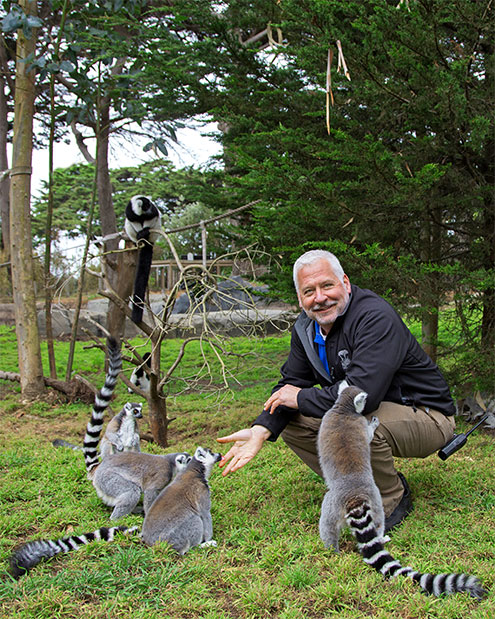by Patricia Yollin
David Bocian is on a mission to improve the lives of all who reside at the San Francisco Zoo.

Photo by Marianne Hale
David Bocian(M.A.,’99) has served as a foster parent to a baby siamang, studied howler monkeys in Belize and tracked lemurs in Madagascar.
Now he is vice president of animal care at the San Francisco Zoo, where a Wellness Initiative that began a year ago can be traced to Bocian’s “great mentor” at SF State, Professor of Biology Hal Markowitz, who died in September.
“The genesis of this idea began with Hal,” says Bocian, sitting in the zoo library. “His reputation as an innovator in animal enrichment and empowering animals has been influential throughout the zoo profession.”
In the early 1990s, the professor worked part time at the zoo for six years as research director. At Markowitz’s urging, Bocian went to SF State and earned a master’s in biology with a focus on ecology and systematics. “The relationship with Hal,” he says, “has proved fruitful in many ways.”
Bocian and his five siblings grew up in a Baltimore row house within walking distance of the zoo. When he was a boy, Bocian’s father, a machinist, bought a small piece of land an hour north of the city, and the family went there every weekend.
“It was rural Maryland, not the Rocky Mountains or anything like that, but it instilled in me an appreciation of the outdoors and nature and animals,” Bocian says. “It was significant in how I turned out.”
After graduating from college, he became an animal keeper at the zoo in Baltimore. Three years later, he moved to the National Zoo in Washington, D.C. to work with giant pandas. In 1984, he shifted to the San Francisco Zoo, where he started as a keeper and left as curator of primates in 2008. He headed to the Prospect Park Zoo in Brooklyn, mostly to be close to his dying mother on the East Coast.
In January 2011, Bocian returned to the San Francisco Zoo, which was trying to move beyond a fatal tiger attack in December 2007. “I wanted to come back here because I saw the potential,” Bocian says. “There was a change in leadership and a change in the curatorial group with people here for the long terms that are invested in this place.”
San Francisco Zoo Executive director Tanya Peterson says she was happy to lure Bocian back to the West Coast, adding that “his work with the legendary Dr. Markowitz and his deep knowledge of all species make him a treasure in the zoological industry.”
Bocian is responsible for staff safety and training, visitor experiences and the well-being of about 700 animals representing more than 200 species. One of his biggest challenges is dealing with some antiquated concrete enclosures, such as the chimps’ grotto, the Lion House and the polar bear habitat, all of which will get a minor upgrade this summer.
Bocian is painfully attuned to public perceptions of these exhibits. What people don’t see, he says, is the immense amount of care and attention their inhabitants receive, including animal training that allows staff to perform medical procedures such as drawing blood, giving injections and conducting ultrasound exams.
“I try and remind people of what we have done,” says Bocian, pointing to the Lemur Forest, Grizzly Gulch and mixed-species African Savanna, where animals enjoy a fair amount of autonomy.
He wants to revive collaborations with academia -- the kind of symbiotic arrangement that brought Markowitz to the zoo. The Wellness Initiative, which makes an animal’s physical and mental welfare the top priority, is especially compelling for Bocian.
As an early example, he mentions the zoo’s aye-aye exhibit. To determine whether the nocturnal primates could breed alone rather than in a colony, the zoo increased the height of the habitat and made it pitch-black. Now visitors can see them only twice a day in small tours led by a keeper or guide.
“It’s to ensure that you have an interpretive experience,” Bocian says. “You are made to slow down. But we fashioned the whole thing around the animals’ needs.” The result: the zoo bred three aye-ayes in four years, which was unheard of for the species.
“The visitors who go through have a high-quality experience, and they learn something about how their own bodies work. They are in there 15 minutes. At first they think you’re crazy -- 'There’s nothing here!’ -- And halfway through they see the blue lights and movement and then the animals. And they realize something about their own eyes.”
Being a keeper for more than two decades has helped Bocian in his management role. “I have a lot of empathy and respect for keepers,” he says. “But I also have the background to hold them accountable.”